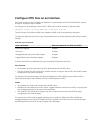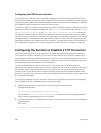
23
Internet Protocol Security (IPSec)
IPSec is an end-to-end security scheme for protecting IP communications by authenticating and
encrypting all packets in a communication session.
Use IPSec between hosts, between gateways, or between hosts and gateways.
IPSec is compatible with Telnet and file transfer protocols (FTPs) and can operate in Transport mode. In
Transport mode, IPSec encrypts only the packet payload; the IP header is unchanged. This is the default
mode.
NOTE: Due to performance limitations on the control processor, you cannot enable IPSec on all
packets in a communication session.
IPSec uses the following protocols:
• Authentication Headers (AH) — Disconnected integrity and origin authentication for IP packets
• Encapsulating Security (ESP) — Confidentiality, authentication, and data integrity for IP packets
• Security Associations (SA) — Necessary algorithmic parameters for AH and ESP functionality
IPSec supports the following authentication and encryption algorithms:
• Authentication only:
– MD5
– SHA1
• Encryption only:
– 3DES
– CBC
– DES
• ESP Authentication and Encryption:
– MD5 and 3DES
– MD5 and CBC
– MD5 and DES
– SHA1 and 3DES
– SHA1 and CBC
– SHA1 and DES
Internet Protocol Security (IPSec)
435


















